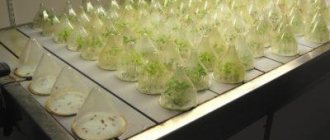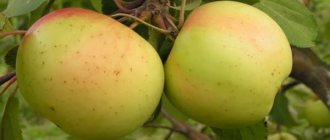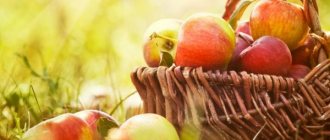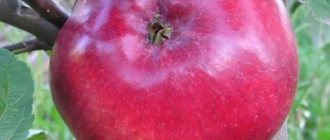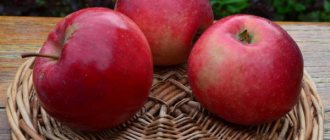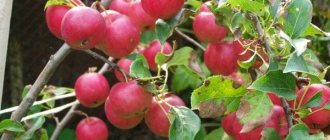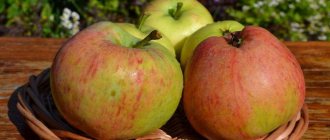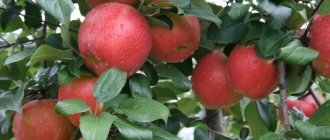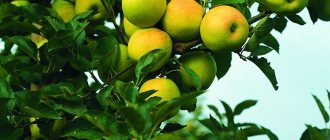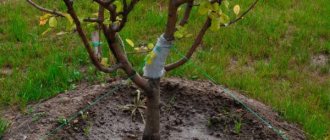In gardening, clonal forms with certain characteristics, as well as seedlings of a particular crop, can be used as the main rootstocks. The former are propagated vegetatively in specialized farms or nurseries. There are several ways to reproduce them:
- Cuttings;
- Horizontal layering;
- Vertical layering.
It is quite difficult for gardeners to carry out such operations on their own. Therefore, the use of seed stocks in private gardening is considered the most affordable and simplest, since they can always be grown on your own plot. As a rule, plants obtained in this way do not retain the varietal characteristics of the mother tree, but are excellent for subsequent grafting of cuttings of the varieties they like.
Some may object. Why bother growing seed rootstocks. After all, you can go to any nursery or garden center and purchase ready-made varietal apple tree seedlings there. But there are pitfalls here:
- There is no absolute guarantee that the desired variety will be purchased;
- There is always a risk that seedlings may end up with a damaged root system;
It is for these reasons that you can try to grow your own rootstocks and graft one or another variety of apple tree onto them.
Rootstock concept
If we consider an apple tree seedling as a separate biological specimen, then, of course, it is capable of producing a root system itself. But such root crops, as a rule, will not begin to bear fruit very soon. And the harvest will have to wait a long time. What won’t happen if you combine cultures correctly. And also choose the right combination of varieties. This is very important knowledge that will affect the yield of the tree in the future. And also on the lifespan of the plant.
The rootstock is a kind of base into which the cultivated plant will be grafted. More precisely, its bud or stalk. Many qualities of the tree depend on the rootstock. This includes frost resistance and fruiting time. Dimensions of branches and trunk, number of flowers and ovaries. Harvest stability. As well as the appearance of the fruit.
Seed differences
It is important to consider whether it is possible to grow an apple tree rootstock from a seed, and also what the difference is between rootstocks grown using different methods. Main features of seeds:
- Growing from seeds has a great advantage - it is not susceptible to diseases in different climatic regions. But the plants that are grafted onto them begin to bear fruit very late. Most often, this process begins after seven years from the moment of planting, and the plant can achieve full productivity only after another 10-20 years. But it is important to remember that such crops will continue to produce tasty and large harvests for the next forty years.
- Experts do not recommend using forest apple trees as a material for picking, since their rhizomes are not as branched as those of cultivated varieties, and therefore replanting the plant will go much worse. It is also important to remember that the yield that the plant will produce will also suffer.
- Rootstocks from seeds and mature trees from them have limited yield in the summer season - only about 15 tons per hectare. This is due to the fact that crops grow quickly, and part of the unproductive crown remains in this state, although many skeletal and semi-skeletal branches are also demanding in obtaining useful substances for active growth and development.
Clonal or vegetative plants are the best option for growing in the garden when the harvest comes first. Trees from such rootstocks have moderate growth and early fruiting. There are a large number of types of vegetative rootstocks, each with its own distinctive features.
Classification of rootstocks
All rootstocks are divided according to different characteristics. The following is a classification of rootstocks, which is based on vigor.
- Vigorous.
- Weak-growing.
- Medium height.
Weak rootstocks, in turn, are divided into semi-dwarf and dwarf rootstocks.
Based on the production technique, rootstocks are divided into seed and intercalary. And also clonal (vegetative). Seed rootstocks include those crops that were grown using seeds obtained from conventional varieties. Here, the growth rate of the plant will be influenced by the variety from which the seeds were obtained.
Most of the varieties that have enviable resistance to cold, both aboveground and underground, are considered vigorous. It is advantageous to use them as rootstocks when grown in less favorable lands. Antonovka and Grushovka seeds are often used for these purposes. Like the seeds of other well-known varieties.
Types and characteristics of apple tree rootstocks in gardening
To understand this issue in more detail, let us introduce some classification. Depending on the method of obtaining (growing) the rootstock, it can be seed, vegetative, intercalary or intercalary. Each type has its own advantages and disadvantages and is suitable for farms of different sizes and types.
Seminal
This type of rootstock is obtained by growing an apple tree from seeds at home. The method is the most labor-intensive and consists of several stages:
- seed procurement (their extraction from fruits, stratification, ensuring proper storage);
- sowing with preliminary soil preparation;
- caring for seedlings, including watering, fertilizing and support.
The advantage of seed rootstock is the longest life span of trees and a longer fruiting period. It has also been noted that with such grafting the frost resistance of plants increases.
Trees on a seed rootstock turn out to be vigorous, for this reason they are planted one at a time. Such apple trees are not profitable for large-scale production.
Vegetative or clonal
This species is obtained by vegetative propagation of the variety chosen as the base. Harvesting such a rootstock takes much less time and effort, and also guarantees that the seedling retains its species qualities.
There are entire nurseries dedicated to breeding seedlings using the green cuttings method.
According to the intensity and vigor of growth, vegetative rootstocks can be vigorous, medium-sized, semi-dwarf and dwarf.
Medium height
The medium-sized rootstock is suitable for any kind of farm. With medium sizes, such grafting helps to obtain maximum yield. The most popular rootstocks are:
- MM-104 , obtained by crossing the Northern Scout species and M2 in England. On fertile lands it manifests itself as a vigorous grower, in any conditions it is characterized by early fruiting and average yields;
- MM-106 , produces trees with high yields and survives frosts well down to -15 degrees, exceptionally medium-sized or semi-dwarf under any conditions;
- M-111 , obtained by breeders in England, is adapted for the warm climate of Ukraine and Central Russia.
Dwarf
Dwarf clonal rootstocks are characterized by high early fruiting, but require the right approach. The trees turn out to be small. According to the intensity of growth and development, they are divided into 5 groups. Widespread:
- M8 , the smallest low-growing trees, require careful monitoring of the condition of the soil and the organization of supports, have weak roots and are poorly retained in the substrate;
- M27 , super-dwarf plants with a poorly developed crown. They produce a small harvest, have brittle branches, require constant care, and are used in small private farms;
- D-1071 , the most resistant species, tolerates frost and arid climates, fruiting begins in the third year, and the yield is high.
Intercalary or intercalary
This technique has become widespread relatively recently. Harvesting is a combination of seed growing of seedlings and grafting of medium-sized varieties. For grafting onto a seedling, a cutting from 15 to 25 cm long is used. Trees grown on such a rootstock maintain a high level of productivity, while remaining stunted. It takes root well in the soil and has average frost resistance.
The disadvantages of such a rootstock include the low strength of the wood, due to which a system of supports for fruiting shoots is required.
Clonal rootstock for apple trees
This is the name given to seedlings that were obtained using the vegetative method of propagating plant forms and species used as rootstocks. Apple tree varieties that are characterized by weak growth are most often propagated in this way. As well as some other fruit crops.
Those agricultural enterprises have specially equipped greenhouses. They can create the conditions of nature. Here the rootstocks are propagated using green cuttings.
Clonal rootstocks have a fibrous root system. Therefore, their advantage is the ability to adapt well in places where groundwater lies close to the surface. And the resulting crops grow evenly and bear fruit at the same time.
One of the disadvantages of the same fibrous root system is the weak stability of the roots in the ground. These plants also need to be watered regularly in the absence of precipitation. So that the earth does not dry out.
Some types of dwarf seedlings for apple trees
Paradise IX is a dwarf rootstock for producing bush forms of apple trees. It grafts well and has high economic and biological indicators. The shoots of the bushes grow thick, brown in color with a yellow tint, covered with thick oval leaves. Up to 10 layerings are obtained from one bush. Due to their shallow root system, they need to be firmly supported when placed in the garden. Seedlings are picky about soil; it is best to grow them in palmette and trellis-dwarf gardens.
Another popular dwarf rootstock for apple trees is Paradise red-leaved. It has high resistance to frost, so it can be grown in the northeastern regions. Shoots and leaves with a characteristic red pigment. The soil for them should be loose and moist. They begin to bear fruit early and the harvest is large. One significant drawback is the fragile wood, which causes the apple trees to lean toward the ground.
Intercalary rootstock
These are rootstocks that are formed using a combination of a seed rootstock and an intermediate insert of a low-growing rootstock. This is a part of the stem, about 20 cm long. It was obtained from the main trunk of a low-growing apple tree. A very big advantage of seedlings obtained on such rootstocks is the low growth of the tree. And also a very rapid entry into fruiting. In addition, the tree is well anchored in the soil.
One of the disadvantages is the mechanical weakness of such forms of apple trees. For example, Budagovsky's Paradise.
Varieties
Some varieties of apple trees cannot be grown from seeds. In these cases, grafting a bud or cutting from a tree of the desired type will help, as a result of which a seedling with the required varietal characteristics will grow from the grafted part.
The part that is grafted to produce a fruit-bearing tree is called a scion, and the part that is grafted onto is called a rootstock. The classification divides them into several types.
Seminal
A seed rootstock is a seedling grown from the seeds of a common apple variety. The strength of its growth and development lies in the varietal characteristics that it transmits to the scion at the genetic level during the grafting process.
To grow seedlings, vigorous varieties of apples, such as Antonovka, Borovinka, Grushovka, are often taken as a seed rootstock, which differ in their characteristics by winter hardiness and strong root system.
The seed shoots are different:
- long period of fruiting;
- stable immunity and unpretentiousness to weather conditions - easily tolerate both frost and drought;
- high productivity.
Their disadvantages include:
- the need for sufficient area for growing seedlings;
- exposure to groundwater due to a highly branched root system growing at great depths;
- fruiting begins only 4-7 years after planting;
- the risk of loss of quality characteristics of the mother variety when cross-pollinated with other varieties.
Clonal
Clonal (or vegetative) apple tree rootstocks are obtained by vegetative propagation from trees, which are taken as the original planting material, rooting a cutting cut from them and, as a result, obtaining a new seedling.
Vegetative grafting with clonal seedlings is often carried out for low-growing and dwarf hybrids.
The peculiarity of this rootstock is its fibrous root system, formed by adventitious roots coming from the central trunk. This allows you to preserve the quality characteristics of the mother tree.
Clonal apple tree rootstocks have a number of advantages:
- the resulting garden crop is uniform in vigor of growth and onset of fruiting;
- seedlings can be grown near places where groundwater flows, because they have shallow root growth;
- The harvest from trees grafted onto a cloned rootstock is harvested annually starting from the 3rd year after grafting;
- the care of short trees is simplified, including pruning;
- ergonomic planting allows you to plant many young apple trees in a limited space.
The disadvantages of cloned grafting include:
- shortened (up to 8, maximum 15 years) fruiting period;
- susceptibility of the root system located on the soil surface to damage by frost and drought;
- It is necessary to install additional supports to prevent trees from falling due to unstable attachment of surface roots in the soil.
Insertable
Intercalary (or incalar) combinations consist of a seedling and an intermediate insert from a weak-growing rootstock. Cuttings 12-22 cm long are cut from the mother plant grown from seeds. They allow grafted seedlings to combine the characteristics of short stature and early ripening with high stability in the soil.
Apple trees obtained on incanal rootstock are not in demand among gardeners, because... they are not highly resistant to temperature fluctuations and have insufficient mechanical strength.
Insert rootstock seedlings are almost never used. An example of apple trees obtained by such a grafting is the dwarf variety Paradizka Budagovsky.
Methods for growing wild game on rootstock for apple trees
Wildflowers are usually grown from seeds. At least that's what happens in nurseries. The seeds are first extracted from the fruit. Then the process of their stratification occurs. This means that the seeds are exposed to very low temperatures. Next, the seeds are sown. And as the seedlings appear and grow, they are plucked. After this, the plants are dug up and rootstocks are planted.
If this is a very large nursery, then mechanized seed procurement takes place here. Here, ripe fruits are placed in special devices. They are called fruit crushers. They are also crushed. If this is not very labor-intensive, then the seeds are harvested by hand.
Rootstocks of fruit crops - the basis for grafting
In amateur gardening, as well as in industrial gardening, the main rootstocks are either seedlings of the corresponding crops or clonal ones, that is, propagated vegetatively (by cuttings, horizontal and vertical layering, etc.) forms that give the variety grafted on them certain characteristics (dwarf growth , increasing the size of the fruit, increasing the yield per unit area, etc.)
The propagation of these types of rootstocks is carried out by specialized farms or departments in nurseries, which grow them for their own needs and for sale. But they are usually sold in large quantities, thousands of pieces, and an amateur gardener who needs a dozen or two, or at most several hundred rootstocks, has to rely mainly on himself. Therefore, let's talk about self-sufficiency of gardeners with rootstocks, especially since they have various methods of propagation at their disposal.
In order for the grafted plant to be healthy and strong, the rootstock must be good. So let's first define what a good rootstock is?
- Firstly, it must have a well-developed root system. That is why it is better for the gardener to grow the rootstock himself in the place where it is planned to grow the fruit plant in the future. In this case, you can do without transplanting the seedling, that is, without damaging the root system, which is inevitable when selecting young plants from a nursery or from a growing bed. If for some reason this option is not possible, then the rootstock can be grown in a container (a milk carton, a flower pot, a cut plastic bottle). The main thing is that the container capacity is large enough for the full development of the root system.
- Secondly, the rootstock must be healthy, without signs of fungal and bacterial diseases.
- Thirdly, mechanical damage is undesirable (however, you can put up with it if it does not weaken the root system).
- And fourthly, if the rootstock is not grown immediately in a permanent place, it should not be too thick. For many generations of gardeners, it is generally accepted that the optimal thickness for a rootstock is the thickness of a pencil. Although a rootstock grown in a permanent place can be much thicker - as long as it matches the thickness of the grafted cuttings.
Let us now turn to seed rootstocks, because growing from seeds is the most widespread and least labor-intensive way to obtain rootstocks. The seeds of all fruit plants grown in our climate require a period of stratification, that is, for a certain time (different for different breeds and varieties), wet seeds must be kept at low positive temperatures. In various publications, the timing of stratification of different crops differs from each other, but basically they can be recognized as follows: apple tree - 70-100 days, pear - 90-110 days, cherry plum - 120-150, plum - 120-180, cherries and sweet cherries - 150-180 days.
From my own experience I can say that it is optimal to sow freshly harvested seeds directly into the ground. Species such as apple and pear will have time to go through the necessary cooling period in the fall and will sprout in the spring at the optimal time. Stone fruit seeds, after the soil temperature has dropped to +5...+8°C, it is advisable to cover them in a spread with old plastic film, and on top of it with dry material - leaf, peat, sawdust with a layer of 15-20 cm, which in turn is on top it must be covered with any material that protects it from getting wet and blown away by the wind. Under such shelter, the seeds have time to go through the cooling period assigned to them by nature, even in snowless winters with severe frosts.
Why do I prefer winter sowing? Firstly, the stratification process at home is quite difficult to control - you need to monitor the humidity, stir the seeds to allow air to enter, and make sure that mold does not appear in bags or boxes. All this is not so simple if you live in a city and stratify seeds in a household refrigerator. And secondly, the biggest difficulty arises in the spring, when the seeds begin to hatch, and they urgently need to be placed in conditions with a temperature close to 0°C. And there’s no way to get out to the dacha. And if you get out and dig up the snow, then underneath there is frozen ground, into which it is also not easy to bury a container with seeds. And if you leave them on the surface of the soil, then where is the guarantee that in a week the snow will not melt, and at night there will be frost of -10...-15°C?
Well, and thirdly, after all, stronger and healthier seedlings are obtained from autumn sowing. When sowing in spring with stratified seeds, germination is higher (subject to all stratification conditions) and there is less chance of losing seeds from rodents. But now there are enough drugs that, when applied in negligible quantities to seed rows, rodents will not even come close to them. In addition, an amateur gardener usually sows seeds with a large supply, so increasing germination during stratification is not a fundamental factor for him.
When seedlings appear on the seed beds, they must be covered with non-woven material (lutrasil, agril), since our feathered friends are very partial to the delicate seedlings. You should not cover the crops with film - they may burn. If you grow seedlings with subsequent transplantation, then at the cotyledon leaf stage the young seedlings should be picked. This is done not only to increase the distance between seedlings and to give them the opportunity to grow and develop freely. This is done mainly to pinch the central root. In this case, lateral roots begin to develop quickly.
As a result, by the fall, when the seedlings can be selectively dug up for winter grafting or transplanted into a nursery for grafting in the spring, their compact root system will suffer significantly less than if it had a highly developed tap root that goes deep into the soil. If you grow seedlings with a planting pattern of 10x15 cm and at the same time mulch the soil with a 5-6 cm layer of compost, humus, vermicompost or simply mown grass, then by autumn from 1 m? you can get 50-60 first-class rootstocks!
the method of growing rootstocks in containers may be useful for the amateur gardener . If you need to have only one and a half to two dozen rootstocks, then it is very convenient.
In the second half of February - early March, you can sow seeds taken directly from the fruits in small containers, since during storage of the fruits the seeds have already undergone stratification in storage, inside the fruit. True, I tried this method only on seed crops. If you want to grow rootstocks of stone fruit plants in containers, it is safer to take stratified (hatched) seeds. Containers for sowing should not be large - two-hundred-gram cups into which coffee is poured in pie shops are quite sufficient. Make several holes in the bottom of the container to drain excess water, pour soil into it and sow the seeds, one at a time, into the pot. Before the emergence of seedlings, the containers are kept at a temperature of about 20°C, and after their emergence they are placed in the brightest place on the windowsill to avoid excessive stretching of the seedlings.
The ideal place for growing is a glazed balcony or loggia, where there is a lot of light and a relatively low temperature. In the future, the seedlings are cared for in the same way as any seedlings: they are fed, if necessary, transplanted into larger containers, and accustomed to open ground conditions. At the end of May - beginning of June, when the danger of return frosts has passed, they are finally transferred to the garden, transferred to containers with a capacity of about one and a half liters and grown in partial shade, not forgetting to water and feed with complete mineral fertilizer such as "Kemira-universal" or liquid organic fertilizers in in accordance with accepted standards (feeding should be stopped from the beginning of July).
Seedlings grown with such care can be selectively budded at the end of July, and grafted with cuttings in August - September. Overwintering plants are left buried in the ground along with the container or transferred to a suitable room for storage (cold greenhouse, basement, etc.) The advantage of seedlings grown in this way is that when planted in a permanent place, the root system of the seedling is not disturbed He immediately starts to grow, as if he was born in this place. And its root system, never disturbed by pinching and root breaks, inevitable during transplantation, develops in accordance with the laws of nature.
Seed preparation
If the soil is light and not prone to flooding, then the seeds can be sown here in the autumn. After which in winter they will receive natural exposure to cold. If, on the other hand, the soil is heavy, then the seeds must be stratified in sand. In this case, the seeds are placed in special boxes with coarse wet river sand. If there are few seeds, they can be stratified in a small flower pot. Here the container in which the seeds and sand are placed is transferred indoors. The temperature is no more than five degrees and no less than three degrees.
If the temperature in the room gets higher, or you see that the seeds have begun to germinate, you need to move the container to the snow. Or even bury it in it. The period of seed stratification will be influenced by the apple tree variety. As an example, an ordinary garden tree is stratified for 3 months. While the seeds of the Chinese apple tree are exposed to cold for at least 70 days. And Siberian apple trees last more than 30 days.
Planting a dwarf apple tree
Remember that the grafting site of the cutting must be located above the soil surface, since otherwise the debris will spread to its roots and the variety will no longer be dwarf.
Planting Tips:
- It is typical for a seedling that the roots are shallow, so try to distribute them evenly in a circle so that they do not bend or protrude to the surface.
- The soil should fit very tightly to the roots, there should be no empty spaces. To do this, each time you throw a portion of earth into a hole, lightly stamp it with your foot.
- Compact more around the edges rather than the center.
- Drive a stake and place the seedling on the north side of the stake. This way you will protect it from burns.
- Dig a hole around the seedling, fill it with water and mulch the soil with peat to retain moisture. Even in rain, the plant needs watering.
- Do not insert a small rootstock into the soil, as it may begin to rot.
Be sure to install some supports. It is better to do this immediately upon landing. Trees can fall due to both weather conditions and heavy fruit. Place a small stake or tube at a distance of 15 centimeters from the tree and tie the trunk to it.
When it comes to dwarf and medium-sized vegetative rootstocks for fruit trees, they always talk about their obvious advantages. And for good reason: low-growing, early-fruiting plants produce high yields of high-quality fruits. But the shortcomings are mentioned in passing, they are short-lived, and require attachment to a support. As a rule, they are silent about the most significant drawback: they require high agricultural technology.
How to sow apple seeds
Seeds must be sown in soil that is prepared and filled with nutrients. To a depth of approximately 2-3 cm, where grooves have been previously made. The seeds are covered with sand. Then, when the seeds are sown, the soil above should be watered. And also lay out a layer of mulch.
As soon as the seedlings appear and before two true leaves grow on them, the seedlings should be picked. Trim the main root by about 4 cm. Seedlings must be planted at a sufficient distance from each other. Then the plantings need to be moistened. And also lay out a sufficient layer of mulch. At first, it is better to create a small shadow for them.
Further care of the plantings consists of timely weeding and loosening. And also feeding. At the beginning of summer, it is necessary to feed apple trees with manure and urea. Consumption: a quarter of a bucket per 1 m of bed. A solution of ammonium nitrate, diluted in a dosage of 40 g per bucket of water, is also used.
How to grow a rootstock?
Most often, summer residents recommend buying a ready-made rootstock for grafting. But there are some amateurs who try to grow it themselves. This is not difficult to do, you just need to follow all the growing rules step by step.
It was already mentioned above that there are two types of rootstocks:
- Seed: pome (apple, pear, quince) and stone fruit crops (cherry, sweet cherry, plum, apricot, peach, cherry plum, sloe, dogwood)
- Clonal - vegetative propagation by cuttings.
When growing rootstocks of seed crops, you should know some of their properties.
Growing seed rootstock
- Seeds or pits are collected from healthy varieties that produce good yields. They need to be washed thoroughly, then spread on natural material so that they dry well.
- You can sow seeds in the fall a few weeks before the onset of frost. Usually this is done in October. In the spring, seeds and pits are planted at the end of April - beginning of May, when the soil warms up well.
- Before sowing, be sure to prepare the area. Clear it of dry grass and leaves, weed the weeds and add nutrients for digging.
For feeding an area of 1 sq. m. necessary:
- 8 kg of compost or humus;
- 50-60 g of superphosphate;
- 20-30 g of potassium salt.
If seeds are sown in the spring, it is necessary to carry out an additional procedure - their stratification:
- for pome crops it lasts for 90-100 days;
- for stone fruits - from 180 to 220 days.
The seeds are buried 1.5-2 cm into the soil at a distance of 2 cm from each other. In this case, you need to take into account soil moisture and seed size. Depending on the size of the seeds, they are buried 2.5 - 4 cm into the ground, and a 6-8 cm section is left between them. In the fall, after sowing, the area must be treated with peat and humus. In the spring, the same fertilizers are applied and the soil is generously watered.
At the first stage of care, you should especially monitor the cleanliness of the area, loosen the soil, and also prevent the appearance of pests. Do not allow the soil to dry out and fertilize on time.
For better plant growth, apply 30-40 g of ammonium nitrate several times, diluted in 10 liters of water with the addition of slurry (ratio of manure and water 1:8-1:10). When leaves appear on the seedling, carry out the first feeding, and after 20 days - the second.
After the sprouts of pome crops have grown well, they need to be thinned to a distance of 6-8 cm. Stone seedlings are not thinned out. The plant can be used as a rootstock after 1-2 years, when it has become steadily stronger.
Growing clonal rootstock
It is best to grow the rootstock from young cuttings that appear in May - June. Their harvesting is carried out only before rooting from the most beautiful and healthy branch. Ideally, it is recommended to cut the cuttings from the middle tier of the green mass. It is necessary to cut off a shoot 10–15 cm long and 7 mm thick.
It is important to cut off the shoot with a sharp tool. From below, at a distance of 0.5 cm from the lower bud, an oblique cut is made at an angle. At the top, the cut is made straight and above the kidney. The 2 lower leaves are cut from the branch. The top part of the sheet is removed from the rest.
Before planting, the site must be prepared: dig well, remove weeds, and water. Plant the cuttings in the ground to a depth of 3-5 cm. Water thoroughly and mulch with peat or humus. Now the cuttings need to be covered with film to create greenhouse conditions.
At the beginning of caring for the seedling, it should be watered well and regularly. Such conditions will be a good start to the strong development of the plant’s root system. After planting, it is recommended to water several times a day for 14 days. Then they switch to watering once a day, and after a while - 3 times a week.
Loosening the soil is allowed only after the rootstock has grown 10 cm in height. After 1-2 years, the tree will take root well and can be grafted.
Watch the video! How to grow clonal rootstock
Using all the rules for growing a rootstock, you can later get the desired result.
How to combine apple tree rootstock and scion
The varieties combine very well with apple trees such as Antonovka, Grushovka and Borovinka. The worst compatibility is observed with the Raneta Purpurova variety. And also with the Chinese variety. To be more specific, the Kitayka rootstock cannot be used for varieties such as Anis and Antonovka. They go well with the Velvet apple tree variety and others. If the varieties turn out to be incompatible, then in the future the apple tree will show signs of starvation. And the root system will most likely die.
In addition, the apple tree does not combine well with hawthorn and serviceberry. As well as other pome-bearing species. Crops combined in this way will have a short life span.
Development of a clonal plant
Such a culture is not some kind of miracle of genetics. It arose after the selection of new varieties and grew from seeds. Subsequently, the breeders decided to slightly change the principle of plant propagation. This is because seedlings grown from seeds can cross-pollinate with other apple trees and acquire more and more unusual qualities. For example, develop the property of intensive growth from a pollinator.
And when carrying out vegetative propagation, breeders guarantee the production of a crop that will retain its rapid growth and all the positive features of the crop that has become the rootstock. Clonal apple tree rootstocks are very often used by gardeners; many grow plants in a greenhouse through vegetative propagation, and then sell the resulting crop from the plants through a network of special stores and retail outlets.
Place for vaccination
The place where you plant another plant will affect the condition of the seedlings. Especially when it comes to weak-growing rootstocks. Because in order to preserve the necessary qualities of the crop, grafting should be organized so that the vigorous scion does not come into contact with the soil. If this rule is not followed, the scion may take root. While a low-growing crop will lose its dominant properties.
Here you should pay very close attention to the clonal and intercalary rootstock. When planting an apple tree seedling on a clonal rootstock, the plant should be grafted about 3 cm above the soil. When using the insert method, the grafting location will depend on the weather conditions of your region. If the climate is characterized by a large amount of precipitation in the form of snow, then the insert is left above the ground. If there is little precipitation in winter, then the insert is deepened into the soil by about 1/3.
You can also use stems that are 15 cm higher as grafting. In this case, the vaccination is done using the copulation method. If we are talking about the spring period, as well as the budding method in the summer.
What types of rootstocks are there?
The classification is based on the growth vigor of the rootstock; the official division includes 5 types: early-growing superdwarfs, dwarfs, semi-dwarfs, medium- and vigorous-growing varieties.
The choice of a suitable variety is determined by the scale of fruit production and the size of the garden space.
Seminal
Apple trees grown from seeds differ in characteristics from the parent samples.
The valuable properties of the mother plant are inherited by 30-40%, so the main advantage of the method is improved winter hardiness and disease resistance.
The trees grow branched, are decorative, bear fruit 6-10 years after grafting, but retain fruiting up to 50-60 years.
Germination makes it possible to increase the frost resistance of the root system of plants cultivated in northern and western latitudes and in areas with frequent dry periods.
To make rooting faster, use picking and hilling, which increase the branching of fibrous rhizomes.
The disadvantage is a significant height of 6-7 m, if the mandatory spring-autumn crown formation is not carried out.
Clonal
The method is used for vegetative propagation of low-growing hybrids. The seedlings will be identical to the parent tree; they are obtained by green cuttings or by preparations stored at home in the winter.
At the same time, it can be grown near groundwater. The roots are located close to the surface, which obliges gardeners to tie up the trees and water them regularly.
To get a rich harvest, it is recommended to pick off flowers 2 years after planting, avoiding depletion of seedlings.
The first apples ripen within 3-4 years. They are one size, the removable maturity is the same.
The sooner a grafted apple tree begins to bear fruit, the better the taste of the fruit and its weight, but the life cycle will decrease to 25-40 years.
How to determine rootstock for an apple tree
If the seedling is grafted, then here you can find out the type of rootstock. If the rootstock is seed, then its root system will contain a tap root. And also several strong shoots. If the rootstock is clonal, the root system of the seedlings will be fibrous. However, professionals in their field can also determine the origin of the rootstock by the shape of the rootstock.
Characteristics of rootstocks of various varieties
Niedzwiecki apple tree . This variety is very popular in Central Asia. And also in Kazakhstan. In the central part of Russia, the variety is not used as a rootstock. Because the resulting crops die out.
Chinese . This apple tree variety has excellent frost resistance. In addition, the variety is drought resistant. As well as common fungal diseases. This apple tree is often planted for the purpose of landscaping the area. In addition, the variety can be used as a rootstock. But it is necessary to take into account the compatibility of varieties. The apple tree combines best with Melba, Autumn Striped and others. This variety should not be combined with Anise and Antonovka. Therefore, if you use Chinese as a rootstock, you need to carefully approach the issue of compatibility of varieties.
Variety Sibirskaya Yagodnaya . This variety has a very wide variety of forms. Medium-growing varieties and vigorous crops. They can grow up to 10 m in height. Often this apple tree is used as a rootstock in the Ural and Siberian regions. This culture goes very well with Antonovka Shafranna and Borovinka. And also with Papirovka. The tree's root system tolerates frost well. However, it does not tolerate dry summers. Crops can be propagated by seeds. And also parts of the roots. The short growing season makes it necessary to perform early budding. Unlike other rootstocks.
Purple apple tree . This hybrid was obtained by combining the Niedzwiecki apple tree and the dark red apple tree. The variety has good winter resistance. Withstands frosts down to -30 degrees. Therefore, it is very actively grown in the central zone of Russia. And also in its southern part. There is currently little information about the combination of this variety with other varieties.
Apple tree Raika . This variety of apple tree can often be confused with China. However, these are completely different cultures. The variety is very popular as a dwarf rootstock. It is used in private households. And also in large industrial enterprises.
Choosing an apple rootstock: the best options, opinions of residents of Russian regions
First, we will consider the main clonal varieties, then we will go over the well-known universal seedlings, and then we will find out the “rootstock” preferences of Russian gardeners.
Clones
We will select one or two of the most tolerant and productive varieties in each group.
Vigorous: A-2, MM-104
Trees on these rootstocks:
- hold well in the soil due to the powerful root system (support and shelter from the wind are not needed);
- withstand ground freezing down to -14 °C;
- drought-resistant (both were tested in the Southern Federal District);
- live and bear fruit abundantly for 45–50 years.
Recommended cultivars for grafting:
- Antonovka vulgare.
- Borovinka.
- Golden Delicious.
- Idared.
- Mac.
- Winter golden parmen.
- White rosemary.
- Starking.
A common disadvantage of vigorous rootstocks is the relatively late period for the grafted tree to begin bearing fruit - 6–7 years.
Medium height: 54–118, MM-106
Compatible with all varieties of apple trees. Scions 54–118 and MM-106 bear fruit from 4–5 years of age and live for 3–4 decades. Both rootstocks are easily propagated by layering (usually vertical), producing up to 6–7 clones per season. The roots of adult specimens reach a depth of 120 cm, not afraid of high groundwater levels and reliably keeping the tree from collapsing.
These varieties increase the resistance of cultivated apple trees to unfavorable natural factors:
- soil freezing: 54–118 - down to -16 °C;
- MM-106 - up to -12 °C.
Both rootstocks are ideal for grafting winter (that is, the latest) apple cultivars:
- Florina.
- Gala Mast.
- Idared.
- Golden Delicious.
- Renet Simerenko.
Grade 54–118 is often used as an intercalary insert. This is the name of the part of the stem of an individual plant, placed between the rootstock and scion and serving to enhance drought and frost resistance, as well as the yield of the tree. MM-106 has one serious drawback - high susceptibility to late blight.
Semi-dwarf: M-7
This rootstock is compatible with zoned (acclimatized) varieties of the Moscow region and southern regions of Russia. Without shelter and snow cover, the roots of the plant freeze slightly at an air temperature of -25... -27 °C. The variety is very convenient for budding (grafting with a fragment of wood with a bud), since the tree bark is easily separated from the trunk. M-7 is resistant to constant excess or lack of moisture in the soil. It reproduces without problems by vertical layering: up to 8 pieces per year, rooting lasts 10–30 days.
M-7 rootstock is often used as a “shortening” base for vigorous varieties:
- Welsey.
- Winter parmen.
- Jonathan.
- Coke.
Apple trees grafted onto M-7 bear fruit within 3–4 years, immediately producing ultra-high yields due to a sharp slowdown in tree growth, which is initially very intense. With proper fertilizing, regular watering, proper scab prevention and control of the codling moth, yields can reach 500–650 kg per hundred square meters (under normal conditions - 150–400 kg) with a planting pattern of 4 × 2 m, that is, from 12–13 trees.
Semi-dwarf apple trees can be planted according to a 3 × 2 m pattern (15–16 specimens per hundred square meters), if in the future the annual growth of skeletal branches is regularly trimmed to 2–3-year-old wood.
Dwarf: M-9, B7–35
M-9 is the most popular low-growing rootstock variety in Russia. Apple trees live on it for 30–40 years, bearing fruit from the age of 3 and yielding 10–35 kg per season from one tree. The root system of the rootstock lies at a depth of only 60 cm, and the wood of M-9 is quite fragile - so the plant needs support. A layer of turf in the tree trunk that secures the roots will be very useful. Watering is required as the top layer of soil dries.
Possible regions for growing apple trees on M-9 in the Russian Federation:
- in a slanted (oblique) form, with winter cover of the tree trunk circle with 15–20 cm of mulch from grass or leaves: Kaliningrad, Leningrad, Arkhangelsk and Amur regions;
- Central Non-Black Earth Region;
- North Caucasus.
Main scion varieties for M-9:
- Dawn of Alatau.
- Jonathan.
- Aport.
Less known, but more promising is the B7-35 variety. Here are its advantages over M-9 (with the specified scion-rootstock combinations):
- increased drought resistance (the rootstock is zoned in the south of Kazakhstan);
- better adhesion to the ground (roots grow up to 120 cm);
- the yield is 1.4–1.8 times higher: Aport and Zarya Alatau - 130 kg, Jonathan - 230 kg (per hundred square meters);
- the remainder of edible fruits after storage is 94% versus 89%.
When propagating M-9 by layering, it should be taken into account that out of every 7–8 shoots of one mother plant, only 2–3 develop a viable root system (take root in 20–45 days). There are almost no dormant buds on the root collar of the rootstock, so cloning using the “horizontal” method is preferable (see instructions below).
Superdwarf: SK-3, M-8
The general and main advantage of such rootstocks (besides versatility) is that apple trees grafted onto them begin to produce full-fledged harvests already in 2–3 years. Here are the personal advantages of each variety:
- SK-3 - resistant to heat and prolonged drought, withstands frosty (up to -30 ° C) snowless winters (zoned in the North Caucasus).
- M-8 - does not suffer from high groundwater levels (0.5–0.3 m) and severe soil salinity.
Proven varieties for grafting:
- Idared.
- Borovinka.
- Delicious (any representative of the group).
Unfortunately, both rootstocks have extremely fragile wood and are very poorly anchored in the ground by their roots. In view of this, trees should be supported in the first year after grafting. Another significant drawback of superdwarfs is the short lifespan of scions (about 15 years).
Seedlings
Among the cultivated apple tree rootstocks for seed propagation, the following are most often used:
- In the south of Russia - drought-resistant: Astrakhan white.
- Borovinka.
- Astrakhan red.
- Stolbovka.
- Grushovka revel.
- Antonovka.
But here are the most productive and unpretentious, and therefore the most popular wild seedlings:
- Ranetka is purple. Frost-resistant (-35 °C) rootstock for small-fruited Chinese apple trees: K. golden early, K. dark red, K. Kerr, K. dessert. Of the large-fruited scions, only Pepin saffron is suitable.
- Ya. eastern (Caucasian). The variety is resistant to drought and frost (-30 °C). Ideal rootstock for cultivars: Renet Peasgooda.
- Mac.
- Melba.
- Suislepskoe.
- Grushovka Kuban (Vinogradka).
- Winner.
- Gold autumn.
The same rootstock can form trees of different heights depending on growing conditions. A typical example is the clonal variety A-2, the scions of which can be either medium-growing (on ordinary soils) or vigorous (on fertile chernozem). The dimensions of the grafted tree are also artificially regulated by annual pruning of the main conductor (the most developed skeletal branch), thanks to which the central growth point each time moves to the second largest shoot of the crown. This leads to inhibition of the growth of the aboveground part of the apple tree.
Video: one-year-old specimens of the varieties Florina (MM-106) and Renet Simerenko (unknown wild rootstock seedling)
Reviews and recommendations
And here are the rootstocks that practicing gardeners in Russia prefer.
South
My leading apple rootstocks are M-9 and MM-106. The M-9 is very popular in the Krasnodar region. A tribute to fashion, so to speak. The future belongs to dwarfs!
Goldrise
https://forum.ruspitomniki.ru/viewtopic.php?p=6629
Moscow region
In my opinion, if you know how to graft, growing a dwarf apple tree is not a problem. Much depends on the type of soil and groundwater level in the area where the garden is located. If the ground level is high, this is a reason to use a dwarf rootstock, and when it is low, and the soil is sandy, the dwarf rootstock will give a weak root system and it will be difficult for the apple tree to grow a full-fledged harvest. On our sands near Moscow, for example, dwarf rootstocks do not live long. There is only one way out - to have a rootstock with a normal root, make an insert on the trunk - a dwarf, and then graft what you need onto it. We have such an apple tree, it is clearly over 60 years old, the crown has always been very compact.
pullava
https://websad.rf/archdis.php?code=1072897&subrub=%CF%EB%EE%E4%EE%E2%FB%E5%20%E4%E5%F0%E5%E2%FC%FF
Risky farming zones of the Russian Federation
In my opinion and experience, apple trees in the north of Siberia, the Urals and the European part of Russia should be grown obliquely, in small trees with a low crown: either on a dwarf rootstock or in bush form. Naturally, dwarfs will need more intensive pruning of the annual growth by 2-3 buds, but all this work will more than pay off with the fruits grown.
Zakhvatkin M. N., Candidate of Biological Sciences
https://www.vashe-zdorovie.ru/article/nostalgiya/tree/letercad/povy6enie_zimoctoikocti_plodovyh.htm
Non-standard rootstock for apple trees
Other fruit crops are often used as rootstocks.
Rowan . If there is no more suitable specimen as a rootstock, then rowan rootstock is used. However, the resulting variety is characterized by a short lifespan. Because trees have different growth rates. And also the thickness of the barrel.
Hawthorn . This crop can be used as a dwarf rootstock for an apple tree. However, here it is necessary to maintain a distance before vaccination. It should be at least half a meter from the ground. The resulting plant bears fruit very quickly. And also at the same time a very short life span. Scientists consider it illogical to use hawthorn as a rootstock. This experiment can be done for fun. Or to decorate the site with exotic crops.
Irga . Serviceberry and apple tree can be combined, given that serviceberry is completely undemanding in terms of care. And also to the place of growth. Adapts well to any climatic conditions. But here, different thicknesses of crop trunks can negatively affect the growth of the resulting plant.
Rootstocks for different crops
For successful fusion of the rootstock and scion, many factors must be taken into account.
One of them is botanical relationship. Better results can be achieved by carrying out intraspecific grafting (for example, wild cherry is used as a rootstock, and varietal cherry is used as a scion).
Many gardeners also practice grafting between species (for example, the rootstock is cherry plum, and the scion is plum) and even intergeneric grafting (the rootstock is plum, and the scion is peach).
In the table below you can find the most common rootstock options and the most suitable scions for them:
| Rootstock | Scion |
| Quince | Quince, pear |
| Cherry plum | Cherry plum, plum, apricot, peach |
| Chokeberry | Chokeberry, pear, rowan |
| Hawthorn | Hawthorn, pear, apple, quince, cotoneaster |
| Cherry | Cherry, plum, apricot, sweet cherry, peach |
| Wild cherry | Cherry |
| Pear | Pear, apple tree |
| Cerapadus | Cherry |
| Apple tree | Apple, pear, chokeberry, cotoneaster |
| Plum | Plum, apricot, cherry plum |
| Peach | Wild peach and bitter almonds |
| cotoneaster | Pear |
| Irga | Irga, pear, rowan |
Remember that this list is quite relative, and much depends on the specific plant varieties, climatic conditions, soil, etc.
In any case, you can experiment in the process of choosing a rootstock and, of course, try to graft several varieties onto one rootstock - something will definitely take root.
Planting plan
Planting patterns can vary significantly in different climates. Here it is necessary to focus on the growth ability of the variety itself. And also the rootstock. For the Non-Chernozem Zone, the following planting schemes are used. Vigorous varieties combined with a seed rootstock should be planted at a distance of 4 and 6 meters. If the rootstock is intercalary, then they are planted according to a 5 by 3 meter pattern. For clonal rootstocks - 5 by 2 meters.
If we are talking about the southern strip of Russia, then the landing scheme is somewhat different. Dwarf rootstocks are planted at a distance of 1-2 meters. A distance of 4 meters is maintained between rows. As for the depth, everything will depend on the groundwater level. If groundwater flows close to the soil, then grafted apple trees should be planted on a mound.
How to plant seedlings
Dwarf rootstock for apple trees is placed on fertile and nutrient-rich loose soil. The area should be well lit and protected from the wind. Mineral fertilizers can be added to planting holes measuring 100 by 70 cm. To do this, supports are inserted into them, a mound of humus or potassium chloride is covered, and the top is covered with a layer of earth without mineral additives (5-6 cm).
The rootstock is planted so that its roots reach the layer of soil with fertilizer and are covered by the top one. If clay or groundwater is close to the planting, make mounds up to 50 cm high. Care must be taken that the grafted shoot does not end up in the ground. The scion must be 5 cm above the ground, otherwise it will spread to the roots and dwarfism will be lost.
Rules for caring for a grafted apple tree
After you have planted the grafted tree, further care will depend on the survival rate of the new plant. And also on the speed of its development. When the length of the branches reaches more than 40 cm, it is already possible to form the crown of the future tree. The central stem is shortened by three buds in the coming spring. The side branches are adjusted in size so that they are below the top. They are cut and folded back.
How to select and prepare a scion?
The yield and varietal qualities of the fruit tree will depend on the scion. Preparation of branches for grafting begins in the fall after the onset of the first frost. Cuttings are cut from the current year's growth taken from the south side of the tree.
Their length ranges from twenty to thirty centimeters. For storage, the scion is placed in a cold place to keep the buds in a dormant state. This could be a refrigerator or a cellar. The ideal way to store scion is considered to be snowdrifts, where it is placed in closed cardboard boxes and plastic bags, as well as in wooden boxes.
In rare cases, cuttings can be prepared in early spring before the buds wake up.
If the grafting is going to be carried out in the summer, then annual branches with buds are prepared. Before the procedure, the leaves are removed from the cuttings. For the grafting to be effective, the scion branches must be healthy with good buds.
Methods for preparing scions
As a scion, you need to choose those varieties and trees that you like. And which have excellent characteristics. And also good fruiting. It is also necessary to pay attention to the age of the mother plant. He must be at least one year old. It is better to choose those shoots that are located on the south side of the tree, from the edge. If we consider the height of the tree, it is better to take the middle level for the cutting.
It is recommended to cut a cutting for the future rootstock in late autumn. Or even at the beginning of winter. You should check that the branches are not frozen. Strong growths are also more suitable as cuttings. About the width of a pencil. And the length is close to half a meter. It is advisable to store the prepared cuttings under a snowdrift at least 50 cm thick.
If in the growing region the winter is characterized by low precipitation, then before the snow falls, the stems can be shortened to about 30 cm. And put them in a plastic bag, mixing them with peat or moss. Sand will also work. The bag is tied tightly and placed in the bottom compartment of the refrigerator. The optimal storage temperature in this case is one or two degrees.
During the entire storage period, it is necessary to constantly inspect the prepared material for the presence of fungus formation in it. And also make sure that the kidneys do not swell prematurely. If you are growing a rootstock from seeds, you should weed the seedlings here. And also feed regularly, bringing the stem to a width of at least 7 mm. In addition, it is necessary to constantly remove growing branches around the grafting site.
Rootstock, scion, grafting - what is it?
To get new plants, grafting is used. The procedure is based on the introduction of a living part of one tree into the tissue of another. After fusion, a single organism is obtained that will successfully grow and develop.
Grafting is carried out on garden plants when necessary:
- domesticate the wild
- increase the yield of different fruits from one tree
- increase plant longevity
- restore the tree crown
- ensure cross-pollination of crops
try a new variety or replace an old one with it
The main “persons” of vaccination are the scion and the rootstock. The scion is a tree cutting that will be grafted onto the selected tree. The scion can be one bud. Subsequently, it is from the scion that the upper part of the fruit tree is formed, which is responsible for the quality of the resulting variety.
The rootstock is the name given to the plant onto which the cutting is grafted. This lower part of the tree is intended for organizing nutrition and growth. Thanks to the rootstock, the new variety can survive in unfavorable conditions and adapt to it. During grafting, the tree is injured, which will heal successfully if the operation is carried out correctly. The cambium, a layer on the tree trunk located between the wood and the bark, plays a major role in the survival of the scion. The selection of vaccination components is carried out taking into account the purpose of the procedure.
Vaccination methods
There are several ways to graft the required crop onto an apple tree rootstock. If it is spring, then grafting with cuttings will be optimal. This can be copulation, grafting onto the bark. And also grafting into the cleft. If the thickness of the stems of both crops is approximately equal, then it is recommended to do copulation. Oblique cuts should be made on each specimen. Approximately 3 cm.
In the simple version, these slices are simply applied. And if this is an improved option, then it is necessary to make a cut in the form of a tongue. The combined area must be secured by smearing it with garden varnish. Better yet, tie it on top. For example, polyvinyl chloride film or electrical tape. All procedures must be carried out before the buds begin to bloom.
If the thickness of the rootstock stem exceeds the thickness of the scion stem, then grafting is done behind the bark or into a split. Thus, a cut is made under the bark, approximately 2 cm long. It will be necessary to insert a cutting with an oblique cut into it. As described above. Then the wound site is treated with garden varnish. And also wrap it with film or sponge.
If you are grafting into a cleft, here, in addition to the cut, an additional incision is made. You will need to insert a cutting with an oblique cut into it. The junction should be secured with garden varnish and wrapped.
Apple tree planting scheme
Distances in rows and row spacing should be left taking into account the growth vigor of the variety and rootstock, as well as the type of seedling. In addition, planting patterns may vary in different climate zones.
For example, in the non-chernozem zone:
- It is recommended to plant vigorous trees on seed rootstocks according to a 6x4 m pattern,
- On intercalary rootstocks 5x3 m,
- On clonal ones 4-5x2-3 m.
In the southern zones of Russia, it is recommended to leave 1-2 meters between trees on dwarf rootstocks in a row.
The scheme for planting apple trees on a mm 106 rootstock recommends planting them according to a pattern of 4.6 x 1-1.5 m. That is, with row spacing of 4.6 m and with distances between trees in a row from 1 to 1.5 m.
Proper planting and embedment depth. If you did the grafting yourself, then the planting rules will depend on how deep your groundwater is. When standing close, it is recommended to sit on a mound.
Useful videos:
Watch a video about proper planning of an apple orchard:
Watch the video for professional advice on planting apple trees:
For normal planting, it is recommended to prepare a hole for planting with a width of 50 to 80 cm and a depth of 50-60 cm, depending on the texture of the soil and the size of the root system of the seedling.
In this case, the root collar should be at a height of 5 cm above the ground level on the site. Accordingly, the grafting site should also be above the ground.
Rootstock for an apple tree: growing rules
Dwarf and semi-dwarf apple trees are most often propagated using layering. Sometimes propagation by cuttings is also used. Here everything will depend on the plant variety. The following is information on obtaining popular rootstocks such as 54-118, M 106.
First, choose the most important main healthy bush. Here, seedlings that are two years old are planted on rich, fertile soil. And before winter comes, the seedlings are hilled up. You can also fill it with peat or sawdust. With the onset of spring, the upper part of the mother plant is cut off, leaving a small stump. Approximately 3 or 4 cm. Next, after new shoots form on the remaining stump, they should be taken care of. Namely: watering and hilling. Already in the fall, this stem will be ready to become a rootstock, and it is cut off.
The timing of the apple tree entering fruiting here will depend on the quality characteristics of this variety. And also on the level of development of the resulting rootstock. Varieties such as Welsey, Goldspur, Studencheskoe and Narodnoe are fast-growing. If we are talking about classic old varieties grafted onto ordinary rootstocks from seeds, then they can begin to bear fruit only in the seventh year after planting. Or maybe later. And if crops are grown on weak-growing rootstocks, then they begin to bear fruit several years earlier.
Choosing the right rootstock
As a basis for grafting, a crop is chosen that is distinguished by its resistance and longevity. It depends on it whether the renewed tree will receive enough nutrition and moisture. When choosing a rootstock, pay attention to its compatibility with the grafted cuttings. Usually wild plant species act as rootstocks. They need to withstand frost and sunburn.
The creation of ornamental varieties can be achieved by grafting distantly related crops.
You can take shadberry and hawthorn as a basis and combine them with an apple tree. Here it is important to check the compatibility of specific varieties. In the group of stone fruits, it is easier for the gardener to turn around. You can combine cherry plum, peach, felt cherry with each other.
To change the vigor of growth and accelerate fruiting, combine sweet cherries with common cherries. During the grafting period, the condition of the rootstock does not play a special role. It can either be in hibernation or already have leaves. But the age of the rootstock plays a role. The cuttings are grafted onto a tree that is two to three years old. The rootstock can be a stump or a broken tree, which has retained its vitality.
